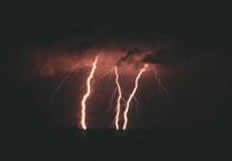
With more than 80 years of experience in the electrical distribution business, Sumter EMC has a tremendous amount of experience in lightning protection. Proper protection for a home or business can be more effective if certain simple principles are followed in initial construction:
- All utilities (power, telephone, cable TV, sprinkler controls, etc.) should enter a building in close proximity to one another, with all grounds bonded together.
- Install surge protection on all utilities at the service entrance location.
- Install point-of-use surge protectors on all electronic equipment.
- When purchasing and installing lightning arresters, look for MOV (metal oxide varister) type arresters.
- Connections for arresters and grounds should be short and straight.
- Connect a grounding lead to any submersible pump frame before installing, and install a high quality lightning arrester at the wellhead with the arrester ground connected to the pump frame.
- Specify shielded wire for sprinkler systems and other wiring that extends a significant distance from the building. Where shielded wiring is impractical, install surge arresters.
- An uninterruptible power supply (UPS) should be used to protect against surges and power outages where equipment is sensitive to power failure.

Sumter EMC installs primary lightning arresters at each distribution transformer pole and on other distribution equipment.
Surge protection equipment on the power distribution system cannot always provide adequate protection to the member’s premises. Steps can be taken by the member to provide a greater degree of protection.
-
Ground properly
Often the grounding of the home (or other structure) is inadequate to protect against lightning. Grounding conductors should be fastened to ground rods with HEAVY DUTY GROUNDING CLAMPS that are suitable for this purpose. This is often treated with too little care. Additional ground rods can be added to improve the grounding. A very effective ground can be accomplished by fastening the grounding conductor to the well casing if the casing is steel and IF the attachment is done properly.
MANY GROUND CONNECTIONS ARE INEFFECTIVE BECAUSE OF POOR ATTACHMENTS -
Install secondary lightning arresters
Secondary lightning arresters can provide a degree of protection when properly installed. They have received adverse publicity because so many have been improperly grounded. Arresters should be UL approved.
A secondary arrester can be installed at the weatherhead, the meter base, or the service entrance panel. An arrester can also be installed on a specific piece of equipment. In any installation, the preferred method of grounding the arrester is to attach it to the steel well casing. If the well casing is not available or it is not steel, the use of multiple ground rods can be used as an alternative.
While the above measures provide some lightning protection, they do not necessarily ALWAYS prevent lightning damage due to the tremendous energy transfer that takes place during lightning storms. Protection against lightning damage should include both protective equipment and insurance coverage to cover losses that might occur in spite of efforts to prevent them.
